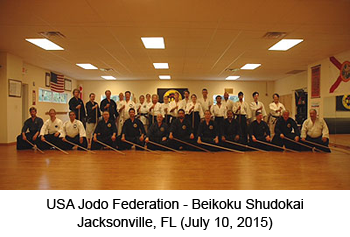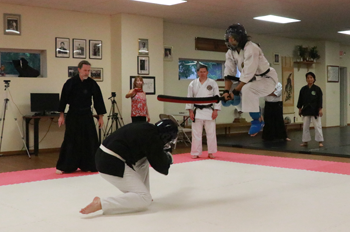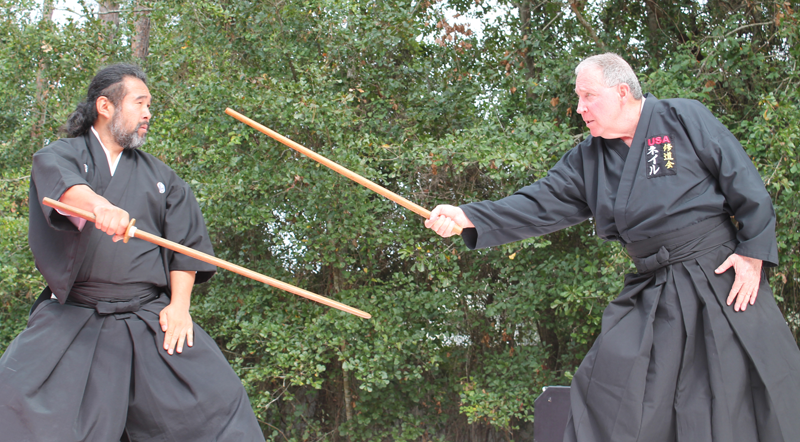USA Jodo Federation
 JODO... IS NOT Judo or Jujutsu, nor "Aiki -Jo"
JODO... IS NOT Judo or Jujutsu, nor "Aiki -Jo"
Jodo, for us which comprised of Jojutsu, is typically known only by those who are directly involved with it, or who are involved in the Japanese martial art such as Kendo, Iaido, Naginatado or like. They may have more exposure to Jodo because of their related samurai tradition.
This is Shindo Muso Ryu Jodo, or interchangeably used, Shinto Muso Ryu.
神道夢想流杖道
Shindo Muso Ryu Jodo
米国修道会
Beikoku Shudokai
Jodo, way of the Jo, is a form of Japanese Budo that uses "Jo" to defend against primarily long sword, Tachi, (and short sword) attacks.
Today's Jo is a straight cane or staff made of white oak in old Japanese measurement of (4-Shaku 2-Sun 1-Bu) that is about 128 cm or 4' 2 1/2" in length, and (8-Bu) about 2.4 cm or 1" in diameter.
 At the USA Jodo Federation - Beikoku Shudokai, first the twelve "Kihon" (12 basic) Jo strikes from the Zen Nihon Kendo Renmei (ZNKF) Seitei Jodo are introduced. Subsequently, 10 "Kata" also from ZNKF are introduced. We introduce ZNKR Seitei Jodo Kata #11 Midaredome in the Chudan Set, and #12 Ran Ai after the Chudan Set.
At the USA Jodo Federation - Beikoku Shudokai, first the twelve "Kihon" (12 basic) Jo strikes from the Zen Nihon Kendo Renmei (ZNKF) Seitei Jodo are introduced. Subsequently, 10 "Kata" also from ZNKF are introduced. We introduce ZNKR Seitei Jodo Kata #11 Midaredome in the Chudan Set, and #12 Ran Ai after the Chudan Set.
Jodo, as it is written and handed down from generation to generation for over four centuries, describes that "Jo" (staff) turns into a spear when you thrust it, a halberd when you sweep it and a long sword when you strike it.
By repeating these combined forms of thrusting, sweeping and striking, the art of Jodo aims to strengthen oneself physically, mentally and spiritually as well as learn to respond quickly against ever changing situations.
Though Jodo is designed to develop well-rounded person in mind, body and spirit, just by repeating the kata without having to apply these techniques in other scenarios it may not naturally develop self-protection skills.
SHU - HA - RI (守 破 離)
Shu, Ha, and Ri represent the three stages in the progression of a student of Budo and other pursuit as well. In the first stage, Shu 守 (which translates as “protect” or “obey” in Japanese), the focus of the student is on acquiring the fundamental skills of the art in the specific tradition of the particular ryu in which they are training. The focus of the instructor is on transmitting the tradition of the ryu as exactly as possible to the student, the goal being laying the foundation of the journey and the preservation of that tradition. If summed up in a single word (from the student’s perspective), this stage might be represented by “accepting.”
 The second stage of the Budo student’s journey, Ha 破 (translates as “break” or “tear” in Japanese), involves developing not only greater skill in, but also a deeper understanding of, the techniques and methods learned during the Shu stage. Having internalized the fundamentals of the style in the Shu stage, the student now begins to experiment with them, taking the pieces apart and putting them back together in different combinations, so to speak. Also, to look at it from another angle.
The second stage of the Budo student’s journey, Ha 破 (translates as “break” or “tear” in Japanese), involves developing not only greater skill in, but also a deeper understanding of, the techniques and methods learned during the Shu stage. Having internalized the fundamentals of the style in the Shu stage, the student now begins to experiment with them, taking the pieces apart and putting them back together in different combinations, so to speak. Also, to look at it from another angle.
At this stage, the Budo student must depend not only on his or her instructors, but on insights generated from within themselves, and investigations beyond the boundaries of the style in which they have been instructed. A reasonable single word representation of this stage might be “questioning,”
By the time the final stage of the Budo path, Ri 離 (translates as “depart” or "separate" in Japanese), has been reached (if it is), the student has now fully understand to walk the own path mentally, physically, and spiritually not only the how, but also the logic and the reason of the ryu. They have internalized their art, and mastered it and made it their own, and may now be able to make their own contributions to it.
There is a subtle, but critical, difference between mastering an art and becoming a master of that art, this being the ability to transmit the art to others and guide them along their own Budo path.
When considering this progression in term of Budo, one must not go to the next stages prematurely; for example, don't even think of going to the HA stage until at least 10,000 hours of training time was invested at the SHU stage. Subsequently, equal or greater effort must be applied at the HA and RI stages. Do not compare Apples with Oranges.
A Jojutsu Master "Hirano Jiro Kuniomi" (1828-1864)
The spirit of Jodo may be best explained in the words of "Hirano Jiro Kuniomi" when he said; "In Jodo, you could instruct a person without killing or injuring even in a fight against the swords." Such kind of spirit is uncommon in the "martial art world" as its natural intention usually is to kill. The core principle of Jodo in his approach was, however, "not to kill" or "let live" as carried out by the six virtues of Jojutsu; love, justice, gratitude, intelligence, faith and courage.
Hirano Jiro Kuniomi was a patriot samurai and at the end of the Tokugawa Shogunate era composed a poem expressing his feeling about the fallen samurai era in Meiji Restoration. "Wagamuneno Moyuruomoini Kurabureba Kemuriwa usushi Sakurajima Yama." It closely states, "compare to my blazing passion, smoke from the Sakura Jima Volcano is very thin." He was a master of Jodo, and his father was a legendary Shindo Muso Ryu Jojutsu master, Hirano Yoshihide.

Shihan George E. Nail (SEPTEMBER 10, 1947 ~ MAY 11, 2018)
Our Budo brother, my inspiration, my Jodo partner and my best friend lived fiercely as a warrior.


